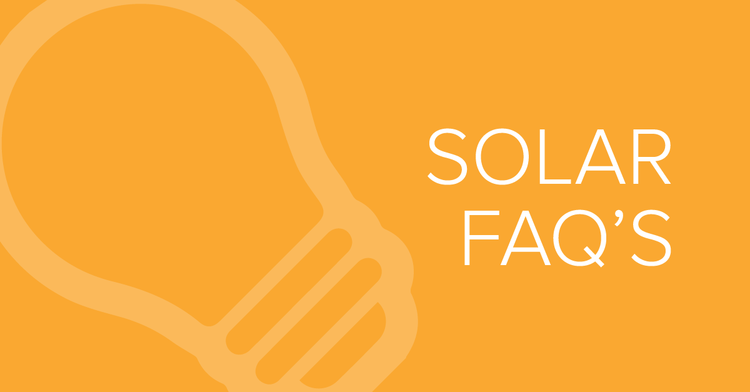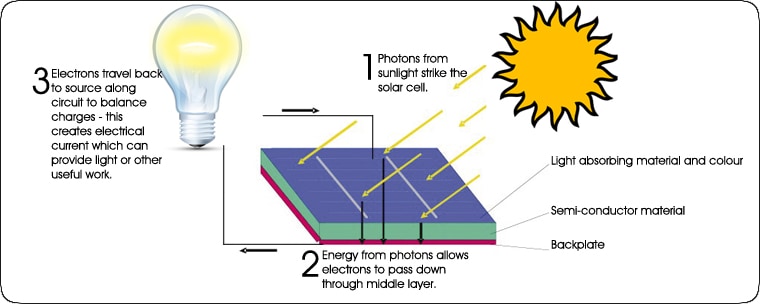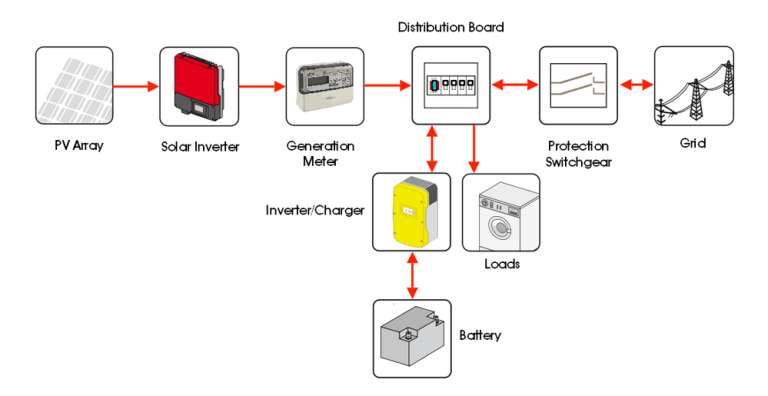
Solar Power FAQ?
1. What is solar energy?

The sun is a source of infinite energy and the energy produced by the sun is called Solar Energy. The amount of solar energy reaching the surface of the earth is so vast that in one year it is about twice as much as will ever be obtained from all of the Earth’s non-renewable sources of coal, oil, natural gas, and mined uranium combined. But most of this free and clean solar energy goes waste in the atmosphere. But with viable technology now available, this energy from the sun can be directly converted to electricity by the use of solar Photo-Voltaic (PV) cells. A large no. of cells are arranged together to form a Solar panel. When sunlight falls on these solar panels, it gets converted to electricity, and this electricity produced from the sunlight is called Solar Power. The complete system generating solar energy is called the Solar system.
2. How does a solar system work?

Solar modules convert the sunlight into DC electricity and in specifications that are not suitable for direct use. Additional components are required to convert, condition, and monitor the electricity produced so that it may be utilized by common appliances used in homes and offices or maybe feed into the grid. This combination of solar panels, inverters, Junction boxes, wires, transformers, and other components that finally deliver useful electricity is called a Solar Photo-voltaic (PV) System or a Solar PV Power Plant. The size of a solar power plant can be very small (1 kW or less) which can be easily mounted on the home rooftop to thousands of MW (covering a huge amount of land).
2.1 What is a grid-connected solar system?
Grid-connected PV systems, as the name suggests, are connected to the electric utility grid. The ground-mounted power Grid-connected plants have size usually greater than 1 MW and feed electricity into the grid. The roof-mounted grid-connected plants have sizes from 1 kW onwards but are mostly less than 250 kW and are usually for captive (self) consumption. There is no electricity storage (battery) with these systems, therefore these can provide electricity only in the daytime. One drawback of this system is that it does not provide the electricity when the grid is down and works only when there is supply from the grid. It reduces the load on the grid by as much power as it is generating. It means they are suitable only for areas which have less number of day time blackouts.
2.2 What is an off-grid solar system?
Off-grid PV systems provide electricity even during the night as they have dedicated battery banks that get charged during the day and the stored electricity can be used during the night. These systems are not connected to the grid and are usually very small in size (less than 50 kW). The large battery banks are the drawback of these systems as they are costly and have to be maintained properly and regularly. These systems are beneficial in Regions with the unavailability of Grid.
2.3 What is hybrid solar system?
These systems are connected to the grid but also have small battery storage or DG set to work with so that the system can produce power in no-grid conditions. This system brings the best of the above two as it is capable of feeding the extra power to the grid as well as provides power when the grid is down within manageable costs.
LET’s Move to MORE Frequently Asked Questions related to Solar Power FAQ
2.4 What is the difference between an on-grid solar system and an off-grid / hybrid solar system?
On Grid Solar
Pros
- Simple design, and low maintenance
- It can be easily integrated for net-metering.
- All appliances can work on it, since wiring does not need to change.
Cons
- Only works when grid power (reference line) available. In case of power cuts, solar electricity cannot be used, since it depends on a reference voltage from grid power.
Best used for
- An on-grid system is ideal when you would like to lower your electricity bills, and do not need power backup.
Off-Grid or Hybrid Solar
Pros
- In areas with unreliable power, people often have batteries and an inverter system for more steady electricity. Solar power can be added to charge batteries faster when grid-power is present, and to power appliances when it is not.
Cons
- Wiring for the solar system is separate, so typically only a few appliances are hooked up to use that electricity.
- Batteries require maintenance and need to be changed every three or four years. Maintenance-free batteries are typically more expensive and so, less popular.
Best used for
- An off-grid system is best suited if you have unreliable electricity and are looking to decrease disruption to your life due to that.
MORE SOLAR POWER FAQ ?
3. What are the major components of solar PV power plant?
Various parts of a solar system are:
- Solar photo-voltaic panels
- MPPT inverters
- Solar charge controllers
- Distribution boxes
- Mounting Structures
- Protection & Controls
- Remote Monitoring System
3.1 What are solar photo-voltaic panel?
Solar PV panels convert the sunlight directly into DC electricity. The panels are rated according to their peak wattage. Note that a 200-watt peak solar panel will produce 200-watt power when kept in sun but the power generated throughout the day will fluctuate depending on the time of day and angle of the panel with the sun. Three types of panels are available in the market, Mono-crystalline, Poly-crystalline, and thin-film type in decreasing order of efficiency. Higher efficiency modules require lesser space for installation. Various Indian and foreign panels manufactures are present in the market providing panels with different peak wattages. The best available panels have an efficiency of around 17 – 22%.
3.2 What are MPPT inverters?
The DC electricity produced by the solar panels is converted to AC by solar inverters. Solar inverters are different from common inverters as they have Maximum Power Point Tracking (MPPT) technology to increase the efficiency of the solar panels. This inverter automatically synchronizes its AC output to the exact AC voltage and frequency of the grid. The efficiency of good quality inverters is greater than 96%.
4.1 What kind of roof is good to install solar panel?
For a Rooftop SPV plant, a flat or south-facing roof is required. The type of your roof and its load-bearing capacity can affect the size of the solar system which can be installed and the type of mounting structures needed.
Concrete roof and Metal roof can accommodate panels directly or with some special structures but in case of the asbestos roof, it is very critical to check the load-bearing capacity and mounting feasibility.
For layman terms, It is most important to have a rooftop available with the lowest shading throughout the day, as neighboring buildings, trees, etc casting a shadow on the Roof might hinder you to Install the maximum capacity Power Plant on it.
But now with Micro-inverters, Roof with Shaded area can also be utilized to mount a Solar Array & thus reap benefits.
Micro-inverters are a bit expensive than the normal string inverters, as for each panel a separate micro-inverter needs to be installed.
We will learn more about micro-inverters in our blog.
4.2 How much area is required to install solar panels for Rooftop Solar Power plant?
The thumb rule implies 10 sqm of area (about 107 sq feet) is required to install 1 kW solar panels. However, in existing buildings often the roof area is already utilized with solar water heaters, recreational areas, water tanks, and lift rooms. This makes solar rooftops often difficult to install in retro-fit buildings but the installation of the solar shed on the roof allows the usage of the roof for solar panels or other purposes.
4.3 Will the solar installation cause damage to the roof?
No. On average, solar panels add only 1-2 kg of weight per square foot of roof area. All roofs are typically able to withstand significantly more weight than this.
Also, when the Site Visit is done by a Solar Octa representative, they will inspect the roof for robustness. In the unusual event of the roof not being able to support the weight of the solar system, they would be able to suggest reinforcement mechanisms that would make a rooftop system possible.
Rooftop systems are very durable and have an average lifetime of 25 years. During this period, if roof work ever has to be done, the rooftop system can be easily dismantled and reassembled. So, future roof work is always possible.
5. What is the energy generated from a 1 kW solar system?
The usual benchmark for energy generated from a 1 kW Solar system is considered as 1,500 units per year. This is a conservative benchmark and actual generation is different for different locations. The amount of actual energy generated from a Solar Power system in a year depends on both internal and external factors. External factors which are beyond the control of a solar installer include the following:
- Number of sunny days
- Solar Irradiation
- Day Temperatures
- Air Mass
The output also depends on the following internal factors all of which are within the control of a solar installer:
- Quality of engineering and design
- Quality of equipment used
- Quality of installation
- Maintenance activities
6. Who can achieve the short term cost benefits by installing a Solar Power Plant ?
Solar Power is beneficial for anyone & everyone, if you have a landmark which receives plenty of sunlight & area available is shadow-free, Solar PV system can be installed on it.
Solar Power system is apt for small consumers, residential, institutional, commercial.
The best benefits for solar power kick in for High end Consumers who fall under the Unit prices starting at
INR 8 / KWh and slabs going all the way up to INR 13 /unit .
These high power consumers , mostly commercial or institutional require uninterrupted power supply & usually deploy Diesel Generator systems , a DG costs more than a Solar System as an initial investment , along side the operational running cost of the DG is higher as compared to the Solar Power .
Acc. to our market research, the generation of a unit for a DG set cost about INR 15/unit, due to Constant Input of Fuel cost, maintenance & system life due to moving parts.
here the cost for Solar Power Generation is INR 5-6/unit.
Those opting for Green Building Certifications , should opt for a Hybrid Solar Power plant with Backup in form of Batteries & a DG set .
7. How much sunlight do solar panels need for Solar Energy Power system ?
Sunlight is important for solar power, but even on cloudy days, the Solar Panels can produce enough power to meet your requirements.
Just be sure to keep your solar panels in a shadow-free area, and they will receive enough sunlight to work.
Solar Panels also work on ambient lighting, but best perform with sunlight, as it packs more energy per square meter .
8. How many solar panels do I need to run my home, office or industry ?
For a home or office with a connection of 15KW – it is not viable to install a 15KW solar system because no one utilizes 100% power all day. Only the main requirements which run continuously can be shifted to solar-like the TV, Computer, AC, Refrigerator, Accessories, etc. Therefore, customers with a power supply of 15KW from the Grid should ideally go for a 5 to 10 KW solar panel installation. This rule also applies to industries that are looking for a Solar Energy System for Power solutions.
Acc. to MNRE & Government of India, 70% of the sanctioned Load connection can be applied for Solar Grid Tie Power Plant, meaning if you have a 10 KW connection from the Utility power Supply aka DISCOM, You are eligible for Connecting a 7 KWp Rooftop Solar Power Plant to the Net-metering Connection with your DISCOM.
This being said ,
It doesn’t mean you cannot Install more of Rooftop Solar Power,
if you have the area available, you are eligible to install as much Solar Power Plant capacity as you want, Conditions being, you will have to consume the power generated on-site, as captive load, and are only allowed to Feed in a Particular number of units per year into the Utility supply by DISCOM, also the DISCOM will Reduce your Feed-in-tariff for the Same.
But,
Hey, if you have a large empty roof, install the maximum capacity of Solar Power Plant, & share some Solar power with your neighbors, They will surely pay you for your Solar Power because it’s Cheap, Clean, Green & Renewable.
We have seen this taking place, & neighbors installing Rooftop Solar Power plants, resulting in a Neighborhood Solar Grid.
Your neighbours will think you did it to save the environment but you know you did it to save Money!
9. What happens when it rains, snows, sleets or hails ?
In bad weather, your panel production won’t be 100%, but your panels will still be producing power. On a cloudy day, your panels might produce 60% to 70% of what they normally would.
The only exception is if it snows enough for there to be a significant accumulation on your panels, your panels will not produce electricity.
Also, Solar Panels from Tier 1 manufacturers are tested for Snow loads & Hail Storms, So your panels will not crack the glass even on heavy hail storms or snowstorms.
Panels get cleaned best by rainwater, as rainwater is distilled water.


Leave a Reply